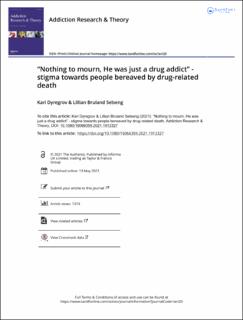| dc.contributor.author | Dyregrov, Kari | |
| dc.contributor.author | Selseng, Lillian Bruland | |
| dc.coverage.spatial | Norway | en_US |
| dc.date.accessioned | 2021-10-13T06:46:51Z | |
| dc.date.available | 2021-10-13T06:46:51Z | |
| dc.date.created | 2021-05-14T09:24:10Z | |
| dc.date.issued | 2021 | |
| dc.identifier.citation | Dyregrov, K., & Selseng, L. B. (2021). “Nothing to mourn, He was just a drug addict”: Stigma towards people bereaved by drug-related death. Addiction Research & Theory, 1-11. | en_US |
| dc.identifier.issn | 1606-6359 | |
| dc.identifier.uri | https://hdl.handle.net/11250/2789489 | |
| dc.description.abstract | Background
Although mortality attributed to illicit drugs is a significant contributor to the overall number of deaths worldwide, knowledge relating to the consequences for those bereaved by drug-related deaths (DRDs) is scarce. Since individuals with substance use disorders are prone to stigma, there is an urgent need for knowledge about the occurrence and content of stigmatization of those bereaved by DRDs.
Method
A mixed methods approach was used. In total, 255 participants (parents, siblings, children, partners, other family members and close friends) who had lost a person to a DRD were recruited. Thematic and descriptive analyses were undertaken on data derived from open-ended and standardized questions from a large survey exploring systematically the contents of interpersonal communication experienced by participants following their bereavement.
Result
Nearly half of the respondents reported experiencing derogatory remarks from close/extended family and friends, work colleagues, neighbors, media/social media and professionals. The main themes were dehumanizing labeling, unspoken and implicit stigma, blaming of the deceased and that death was the only and the best outcome. The remarks were negative and powerful despite being directed at people in crisis and originating from individuals close to the bereaved participants.
Conclusion
Individuals bereaved by DRDs experience harsh and stigmatizing communications reflecting the existing societal stigma toward drug users. This contributes to the marginalization of grieving individuals at a time when they may require support. Making people aware that stigma occurs, why it happens and how it is transmitted in society can help reduce it and its adverse consequences. | en_US |
| dc.language.iso | eng | en_US |
| dc.publisher | Taylor & Francis | en_US |
| dc.rights | Attribution-NonCommercial-NoDerivatives 4.0 Internasjonal | * |
| dc.rights.uri | http://creativecommons.org/licenses/by-nc-nd/4.0/deed.no | * |
| dc.title | “Nothing to mourn, He was just a drug addict” - stigma towards people bereaved by drug-related death. | en_US |
| dc.type | Peer reviewed | en_US |
| dc.type | Journal article | en_US |
| dc.description.version | publishedVersion | en_US |
| dc.rights.holder | © 2021 The Author(s) | en_US |
| dc.subject.nsi | VDP::Samfunnsvitenskap: 200::Psykologi: 260 | en_US |
| dc.source.journal | Addiction Research and Theory | en_US |
| dc.identifier.doi | 10.1080/16066359.2021.1912327 | |
| dc.identifier.cristin | 1909964 | |
| dc.relation.project | Norges forskningsråd: 300732 | en_US |
| cristin.ispublished | true | |
| cristin.fulltext | original | |
| cristin.qualitycode | 1 | |

